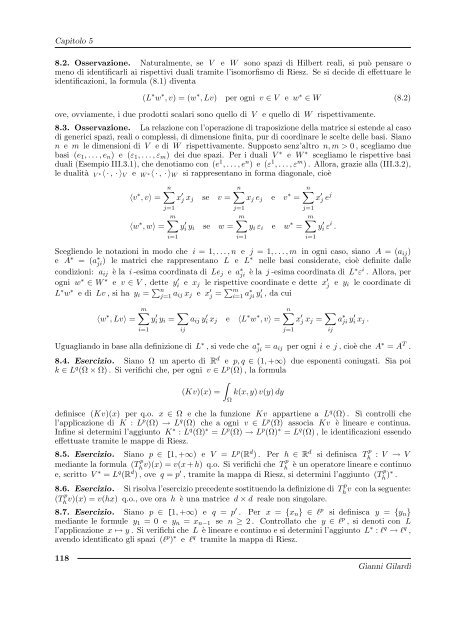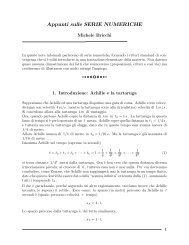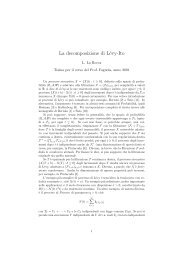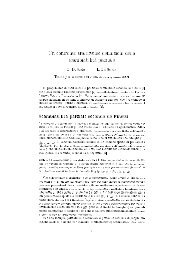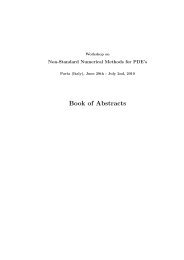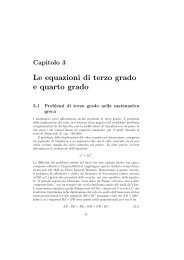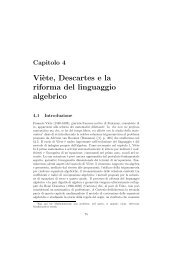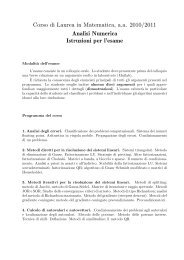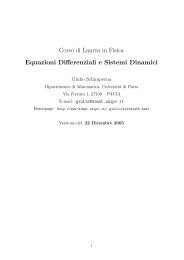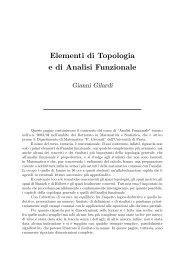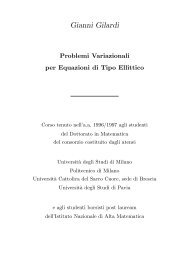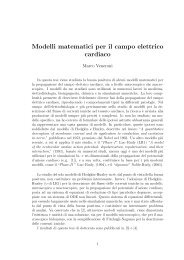G. Gilardi, Analisi Funzionale - Dipartimento di Matematica
G. Gilardi, Analisi Funzionale - Dipartimento di Matematica
G. Gilardi, Analisi Funzionale - Dipartimento di Matematica
You also want an ePaper? Increase the reach of your titles
YUMPU automatically turns print PDFs into web optimized ePapers that Google loves.
Capitolo 5<br />
8.2. Osservazione. Naturalmente, se V e W sono spazi <strong>di</strong> Hilbert reali, si può pensare o<br />
meno <strong>di</strong> identificarli ai rispettivi duali tramite l’isomorfismo <strong>di</strong> Riesz. Se si decide <strong>di</strong> effettuare le<br />
identificazioni, la formula (8.1) <strong>di</strong>venta<br />
(L ∗ w ∗ , v) = (w ∗ , Lv) per ogni v ∈ V e w ∗ ∈ W (8.2)<br />
ove, ovviamente, i due prodotti scalari sono quello <strong>di</strong> V e quello <strong>di</strong> W rispettivamente.<br />
8.3. Osservazione. La relazione con l’operazione <strong>di</strong> traposizione della matrice si estende al caso<br />
<strong>di</strong> generici spazi, reali o complessi, <strong>di</strong> <strong>di</strong>mensione finita, pur <strong>di</strong> coor<strong>di</strong>nare le scelte delle basi. Siano<br />
n e m le <strong>di</strong>mensioni <strong>di</strong> V e <strong>di</strong> W rispettivamente. Supposto senz’altro n, m > 0 , scegliamo due<br />
basi (e1, . . . , en) e (ε1, . . . , εm) dei due spazi. Per i duali V ∗ e W ∗ scegliamo le rispettive basi<br />
duali (Esempio III.3.1), che denotiamo con (e 1 , . . . , e n ) e (ε 1 , . . . , ε m ) . Allora, grazie alla (III.3.2),<br />
le dualità V ∗〈 · , · 〉V e W ∗〈 · , · 〉W si rappresentano in forma <strong>di</strong>agonale, cioè<br />
〈v ∗ , v〉 =<br />
〈w ∗ , w〉 =<br />
n�<br />
j=1<br />
m�<br />
i=1<br />
x ′ j xj se v =<br />
y ′ i yi se w =<br />
n�<br />
xj ej e v ∗ =<br />
j=1<br />
m�<br />
yi εi e w ∗ =<br />
i=1<br />
n�<br />
j=1<br />
m�<br />
i=1<br />
x ′ j e j<br />
y ′ i ε i .<br />
Scegliendo le notazioni in modo che i = 1, . . . , n e j = 1, . . . , m in ogni caso, siano A = (aij)<br />
e A∗ = (a∗ ji ) le matrici che rappresentano L e L∗ nelle basi considerate, cioè definite dalle<br />
con<strong>di</strong>zioni: aij è la i -esima coor<strong>di</strong>nata <strong>di</strong> Lej e a∗ ji è la j -esima coor<strong>di</strong>nata <strong>di</strong> L∗εi . Allora, per<br />
ogni w∗ ∈ W ∗ e v ∈ V , dette y ′ i e xj le rispettive coor<strong>di</strong>nate e dette x ′ j e yi le coor<strong>di</strong>nate <strong>di</strong><br />
L∗w∗ e <strong>di</strong> Lv , si ha yi = �n j=1 aij xj e x ′ j = �m i=1 a∗ji y′ i , da cui<br />
〈w ∗ , Lv〉 =<br />
m�<br />
i=1<br />
y ′ i yi = �<br />
aij y ′ i xj e 〈L ∗ w ∗ , v〉 =<br />
ij<br />
n�<br />
j=1<br />
x ′ j xj = �<br />
a ∗ ji y ′ i xj .<br />
Uguagliando in base alla definizione <strong>di</strong> L ∗ , si vede che a ∗ ji = aij per ogni i e j , cioè che A ∗ = A T .<br />
8.4. Esercizio. Siano Ω un aperto <strong>di</strong> Rd e p, q ∈ (1, +∞) due esponenti coniugati. Sia poi<br />
k ∈ Lq (Ω × Ω) . Si verifichi che, per ogni v ∈ Lp (Ω) , la formula<br />
�<br />
(Kv)(x) = k(x, y) v(y) dy<br />
Ω<br />
definisce (Kv)(x) per q.o. x ∈ Ω e che la funzione Kv appartiene a L q (Ω) . Si controlli che<br />
l’applicazione <strong>di</strong> K : L p (Ω) → L q (Ω) che a ogni v ∈ L p (Ω) associa Kv è lineare e continua.<br />
Infine si determini l’aggiunto K ∗ : L q (Ω) ∗ = L p (Ω) → L p (Ω) ∗ = L q (Ω) , le identificazioni essendo<br />
effettuate tramite le mappe <strong>di</strong> Riesz.<br />
8.5. Esercizio. Siano p ∈ [1, +∞) e V = Lp (Rd ) . Per h ∈ Rd si definisca T p<br />
h : V → V<br />
me<strong>di</strong>ante la formula (T p<br />
p<br />
v)(x) = v(x + h) q.o. Si verifichi che T è un operatore lineare e continuo<br />
h h<br />
e, scritto V ∗ = Lq (Rd ) , ove q = p ′ , tramite la mappa <strong>di</strong> Riesz, si determini l’aggiunto (T p<br />
h )∗ .<br />
8.6. Esercizio. Si risolva l’esercizio precedente sostituendo la definizione <strong>di</strong> T p<br />
h v con la seguente:<br />
v)(x) = v(hx) q.o., ove ora h è una matrice d × d reale non singolare.<br />
(T p<br />
h<br />
8.7. Esercizio. Siano p ∈ [1, +∞) e q = p ′ . Per x = {xn} ∈ ℓ p si definisca y = {yn}<br />
me<strong>di</strong>ante le formule y1 = 0 e yn = xn−1 se n ≥ 2 . Controllato che y ∈ ℓ p , si denoti con L<br />
l’applicazione x ↦→ y . Si verifichi che L è lineare e continuo e si determini l’aggiunto L ∗ : ℓ q → ℓ q ,<br />
avendo identificato gli spazi (ℓ p ) ∗ e ℓ q tramite la mappa <strong>di</strong> Riesz.<br />
118<br />
ij<br />
Gianni <strong>Gilar<strong>di</strong></strong>


